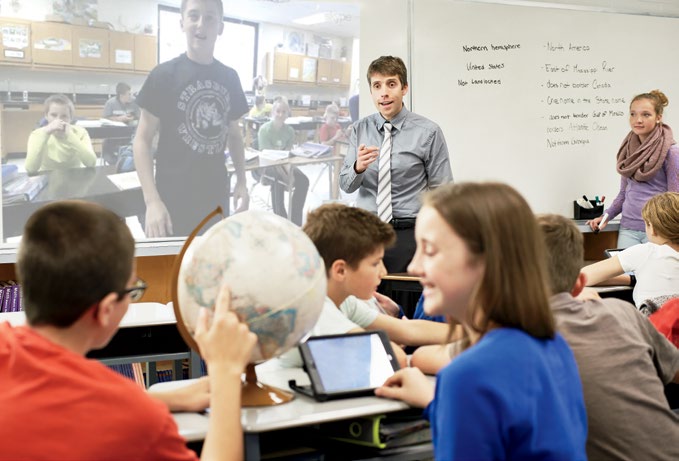Share this page
A Grade 6 teacher uses a Q&A Skype game to help students sharpen their mapping skills and broaden their horizons.
By Stefan Dubowski
Photo: Matthew Liteplo

The Challenge: Help students hone their proficiency with maps, improve their critical thinking and learn about different parts of the world.
The Solution: Use Mystery Skype to link your classroom to others in far-off cities, countries and continents. Challenge students to figure out where the class on the other side of the Skype session is located.
Lessons Learned: Last year, Joe Grabowski, OCT, wanted to help his Grade 6 students at St. John Catholic School in Guelph broaden their cultural knowledge and learn not only through books, but also through experiences. He signed up for Mystery Skype, a global guessing game in which teachers and students use Skype, the free online video-conferencing service, to connect with people in other parts of the world. Players on each side ask questions to pinpoint the other side’s location.
For Grabowski’s class, sessions would last 20 minutes to an hour with students playing specific roles: questioners ask the questions during the game, mappers use atlases or Google Earth or Maps on iPads to verify location data, and note-takers record questions and answers to help the class stay on target.
“We started with a simple exchange, just 20 yes or no questions, switching back and forth with the other class each time,” Grabowski says. “We had our atlases and we went from there with questions like, ‘Are you in the Eastern Hemisphere?’ We would narrow it down to a country, then locations within a country.”
For the final few minutes of each session, students would give short presentations about their city and country, or exchange further questions and answers to learn more about the children on the other side of the Skype call.
Grabowski used his laptop to connect to Skype. He also plugged the computer into his classroom’s interactive whiteboard, making the board into a big screen so his students could see the other children clearly.
Observations: The students quickly grasped which questions would yield the most useful information, such as, ‘What time zone are you in?’ That’s how his students managed to figure out where a particularly hard-to-find classroom was situated.
“We had a really good [game] with a class on the little English Channel Island of Alderney. It’s only three miles by a mile and a half … That was probably our toughest one, but [the students] got it in fewer than 15 questions.”
The Grade sixers also learned about life in other places. They Skyped with classrooms in France, El Salvador and — memorably — Uganda, where students in an orphanage concluded the call with a traditional dance demonstration. “They were thousands of miles away and it was as if we were in the room with them,” Grabowski recalls.
As for Grabowski, the teacher learned that sometimes it’s best to step away and let the students take control. It’s not easy to refrain from feeding questions to students that would help them identify the other class’s location. “You have to bite your [tongue] and let them figure out what’s going on. If I kept [helping them], they wouldn’t grow.
Helpful Hint: Use Mystery Skype to support lessons. When Guelph teacher Joe Grabowski, OCT, was teaching students about Canada’s trading partners, he set up Skype calls with classrooms in the countries with which Canada has trade agreements.
What You’ll Need:
Steps to Take: